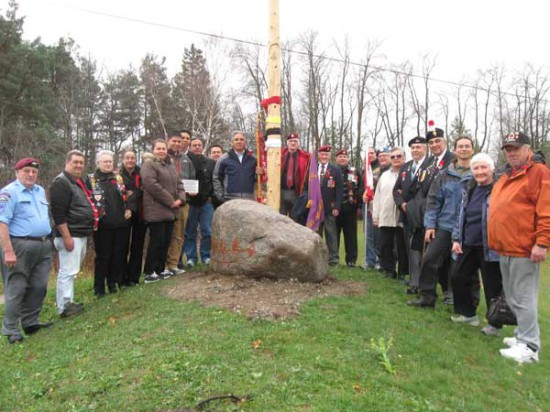M’CHIGEENG—The 7,410 Anishinabek warriors from the Manitoulin Island area who fought in the War of 1812 did so to protect Canada’s borders, a packed M’Chigeeng Community Complex heard from speakers at a peace pole unveiling in honour of the Anishinabek warriors who fought in this war. The ceremony was held in M’Chigeeng on Tuesday.
“We can all be grateful that we have all been put in the same room at this time,” said Chief Shining Turtle, pointing out the gathering, “has brought together.” Young people, older people, veterans, community leaders (such as Grand Council Chief Patrick Madahbee), members of the community and families of veterans.”
Joseph Hare, chief of the M’Chigeeng First Nation, acknowledged the tribal drums, veterans, young people, leadership, and others. “It is such an honour to welcome all of you to M’Chigeeng.”
“Anishinabek played a significant role in crafting Manitoulin-Mnidoo Mnising,” said Chief Shining Turtle, “especially the War of 1812. The peace pole signifies no more war, but peace and harmony and by carrying this out we will all be stronger people.” He pointed out that with the many school children in attendance, “young people are indicators of love, compassion and humility and from war, now approach kindness.”
An Honour Song was presented by Tribal Drum Nimkii, followed by a question posed by Chief Shining Turtle. “So, why are we in this room here today?” he asked, explaining, “On June 18, 1812, US President James Madison signed a declaration of war against Great Britain. It seems odd that the people of Mnidoo Mnising would play such a significant role in a war declared by the president of the US But today you will learn this history and the significant role our people played in this war.”
“And what is very, very important is we have students from some of our schools, Little Current, Lakeview, Assiginack, Central Manitoulin and Shawanosowe School, to learn the history of the War of 1812 and its impacts on our society,” said Chief Shining Turtle.
Colin Pick, president of the War Pensioners of Canada (WPC) Manitoulin-North Shore branch, said “in relation to all the students here today I would thank you for your participation. This is a significant national event, especially for this area. We are recognizing Anishinabek people in the North who have been long forgotten in history books and schools. It is thanks to the UCCMM we are here today, to recognize all these warriors who protected our communities and to keep the Canadian border intact.”
“I welcome Grand Council Chief Madahbee, Chief Hare, and all the chiefs of UCCMM for being here today,” said Mr. Pick. “As we all know, the governments have been spending money in the south for War of 1812 celebrations, but it is very important to remember that of the 8,410 total warriors who fought in the War of 1812, 7,410 are from the Manitoulin, and surrounding areas of the North. This number is a significant contribution in the overall total.”
“The recognition for these local warriors is long overdue,” stated Mr. Pick. “At the peace pole memorial site this recognition will be.”
Alan Corbiere, a local historian, thanked all the organizers for putting the ceremony together. “As Colin said, all the money for this type of celebration has been going to the south, meanwhile many of our ancestors were the ones who travelled down south and made significant contributions in this war. The men took their wives and children, they couldn’t leave them as they would have starved and they needed to provide support to their families. I am grateful and proud of our ancestry and our people who fought for our land.”
I am really honoured to be standing in front of our veterans and soldiers, leaders and young children here today,” said Mr. Corbiere. He went on to tell the story of one warrior, Niibaakum, and his five warriors, Miigwaans, Mishigekek, Eskawkoga, Miishgondaagan, and Mikinaakoong and of their battles and win against US soldiers in a battle down south.
Niibaakum “had all these attributes, but when I was in school I never heard of him,” said Mr. Corbiere. “I had heard of Laura Secord, Brock, and Tecumseh but not Niibaakum,” pointing out the latter and many others from Manitoulin distinguished themselves in the War of 1812, but have since been forgotten by many.
Duke Peltier, chief of Wikwemikong, then displayed a medal he and other area chiefs and those around Canada received in a ceremony held last week, which included the Governor General of Canada, David Johnston, and Prime Minister Stephen Harper, in honour of all those who participated in the War of 1812.
The history of the peace pole was then presented by Dominic Beaudry, who explained he had participated in a similar peace pole ceremony in 2005, as principal at the high school in Wikwemikong. “I had been approached by Colin Pick and Scotty Fisher and we held the ceremony on May 10, 2005.” Similar ceremonies have taken place at other UCCMM First Nation communities.
Mr. Beaudry said many First Nation chiefs took part in a peace pole ceremony in 1701 in Montreal. He said the main reason Anishinabek people took part in the War of 1812 is “that if we hadn’t contributed we and all of Canada could have been part of the US which we didn’t want to take place. We went to war to honour our treaties, but most important to protect Canada, which we all love, and is a beautiful place to live.”
Monikka McGregor, a Shawanosowe school student, read the inscription of the plaque in front of the peace pole. It states in part, “this historic marker stands in remembrance of the First Nations people of the Anishinabeg; Ojibwe, Odawa, Potowatomi, Mississauga, Algonquin and Nipissing, who fought during the War of 1812, to protect their lands from American expansionism, thus these warriors assisted in maintaining Canada’s borders as we know them today.”





